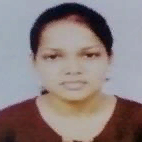
Madhurima Majumder
Work place: Department of Electrical & Electronics Engineering, Mirmadan Mohanlal Government Polytechnic, Gobindapur, Plassey, West Bengal 741156
E-mail: madhurimam128@gmail.com
Website:
Research Interests: Artificial Intelligence, Mathematics of Computing, Models of Computation
Biography
Mrs. Madhurima Majumder is currently acting as a lecturer in Department of electrical & Electronics Engineering Department, Mirmadan Mohanlal Government Polytechnic Institute, India. She received her B.Tech from MAKAUT, India in 2019. Presently she persuing M Tech from MAKAUT. Till now she published 3 research papers in a reputated journal. Her research interests are Internet of Things & Artificial Intelligence.
Author Articles
Parametric Optimization of Drilling Parameters in Aluminum 6061T6 Plate to Minimize the Burr
By Pijush Dutta Madhurima Majumder
DOI: https://doi.org/10.5815/ijem.2021.06.04, Pub. Date: 8 Dec. 2021
In the manufacturing, process a burr has been observed during the drilling through a hole in an aluminum bar. From the view of the life of a product, minimization of the burr should be significant. So in this research main aim is to identify how input parameters: drill diameter, point angle & spindle speed influenced output parameters burr height & thickness. To execute this operation a total of 27 examinations on an Aluminum 6061T6 plate is taken. Overall research performed into two stages. In first stage, Surface response methodology is used to design two objective functions for burr height & thickness with the help of input parameters and then these two objective functions combined to construct a single objective function. In next stage improved version of elephant swarm optimization (ESWSA) algorithm is applied to get the optimum input parameters. The predicted output variable after the optimization techniques (Test 2 & Test 3) further checked with experimental result to determine the accuracy of the proposed model. In a conclusion section it is seen that the average error of drill diameter, drill point angle & spindle speed are 1.72%, 3.84% & 3.89% respectively with average RMSE is 2.56 *10^-6. For further validation of effectiveness of proposed model is also compared with the state of art techniques in the field burr minimization.
[...] Read more.Parametric optimization of Liquid Flow Process by ANOVA Optimized DE, PSO & GA Algorithms
By Pijush Dutta Madhurima Majumder Asok Kumar
DOI: https://doi.org/10.5815/ijem.2021.05.02, Pub. Date: 8 Oct. 2021
Control of liquid level & flow are the most interest domain in process control industry. Generally process parameter of the liquid flow system is varied frequently during the operation. So the selection of the level of process parameters i.e. input variables seems to be important for achieving the optimum flow rate. In the present work focus is given on the identification of the proper combination of the input parameters in liquid flow rate process. Flow sensor output, pipe diameter, liquid conductivity & viscosity have been taken as input parameter; flow rate obtained from test is taken as response parameter. Till now several researchers have been performed various optimization methods for optimized the parameters of the process plant. But still computational time & convergence speed of the applied optimization techniques for the modelling of the nonlinear process system is still an open challenge for the modern research. In this research we proposed three evolutionary algorithms are used to optimize the process parameters of the nonlinear model implemented by ANOVA to mitigate the unbalance, convergence speed and reduce the total computational time. Overall research performed into three stage, in first phase nonlinear equation ANOVA has been used for mathematical model for the process, In second stage three evolutionary algorithms: GA, PSO & DE are applied for parametric optimization of liquid flow process to maximize the response parameter & in last phase comparative study performed on simulated results based on confirmed test & validated our proposed methodology.
[...] Read more.An Improved Grey Wolf Optimization Algorithm for Liquid flow Control System
By Pijush Dutta Madhurima Majumder Asok Kumar
DOI: https://doi.org/10.5815/ijem.2021.04.02, Pub. Date: 8 Aug. 2021
Liquid flow in a process industry is one of the significant factors which should be controlled to get the better quality and decrease the expense of generation. Customary methodology includes manual tuning of the input process parameter to obtain the required flow rate is tedious and exorbitant. Notwithstanding, estimation of a precise computational model for fluid stream control procedure can fill in as elective methodology. It is only a non-straight enhancement issue. As a contextual investigation, the WFT - 20-I measure control arrangement for flow rate measurement and Control issue is thought of. In this work we proposes a hybrid improved particle swarm optimization (PSO-GWO) used to start the people's position, which can build the decent variety of the wolf pack, balance the global and neighborhood search capacity of the calculation and improve the intermingling pace of the calculation contrast with the Gray wolf enhancement (GWO) and Particle swarm advancement (PSO). Non linear models are improved utilizing those recently proposed streamlining strategies. Additionally all the utilized optimization techniques can anticipate the fluid stream rate with good exactness. The outcomes were investigated by utilizing the root mean square error (RMSE), exactness, and the different measures to evaluate the level of identification performance of the liquid flow contextual analysis model. The trustworthiness of the present models was compared with the past model for similar subsystems utilizing competitive intelligent methodologies. The measurable examination of the acquired outcomes produced the proposed HPSOGWO has most elevated generally speaking proficiency (i.e.99.96%) and it beat the others strategies for the majority of the instances of demonstrating for fluid stream control process. The outcomes of the present model show that the proposed approach gives prevalent demonstrating execution and outflanks its rivals.
[...] Read more.Other Articles
Subscribe to receive issue release notifications and newsletters from MECS Press journals